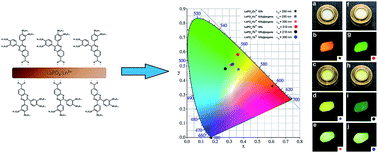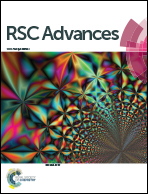Eu3+ and Tb3+ doped LaPO4 nanorods, modified with a luminescent organic compound, exhibiting tunable multicolour emission†
Abstract
Co-precipitation reaction followed by hydrothermal treatment were used to synthesise Eu3+ or Tb3+ doped LaPO4 nanorods, of 5–10 nm in width and 50–100 nm in length. Surface modification of the as-prepared nanoparticles with a selected luminescent organic compound resulted in formation of hybrid inorganic–organic nanomaterials. The products obtained exhibited tunable multicolour luminescence, dependent on the surface modification and applied excitation wavelength. The colour of their emission can be altered from red-orange to yellow-green. Powder X-ray diffraction (XRD), high resolution transmission electron microscopy (HRTEM) and scanning transmission electron microscopy (STEM) confirmed the structure and morphology of the products synthesized. Successful surface modification of the nanophosphors was evidenced by analytical and spectroscopic techniques such as dynamic light scattering (DLS) – providing size distribution histograms and zeta potentials of the nanoparticles; IR spectroscopy and elemental analysis which proved the presence of an organic phase in the structure; spectrofluorometry (excitation/emission spectra and luminescence decay curves) which confirmed the formation of hybrid, surface modified nanomaterials revealing tunable multicolour emission.


 Please wait while we load your content...
Please wait while we load your content...